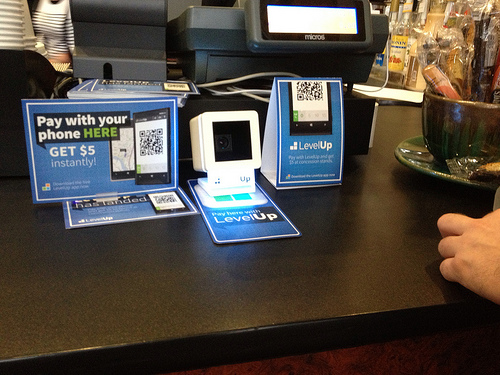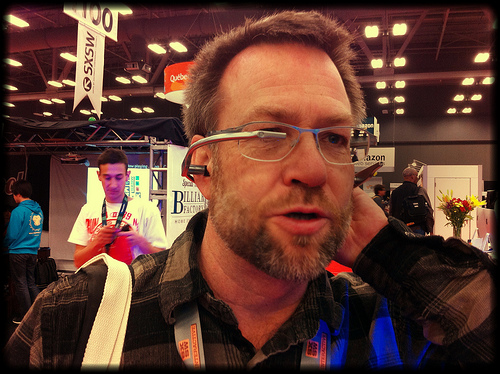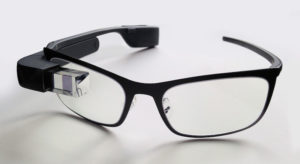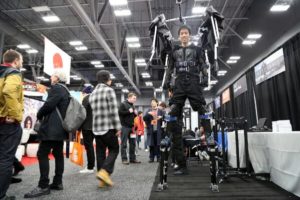Note: SXSW in Austin Texas bills itself as “The Place Where the Future is Invented.” Hyperbole aside, it’s an incredibly rich playground of both highly practical panels full of things we as activists can use today, blended ferociously with entrepreneurs and visionaries pitching ideas and applications that will alter the shape of the world to come. This piece, cross-posted from my blog, is focussed more on that big picture. We may not know yet what to do with wearable computers and in-home 3D printing technologies, but we ignore things that will change the world at our own peril, and that of the planet’s.
The Curmudgeonly Keynote which Bruce Sterling delivers every year at SXSW riffed heavily on the ancient past: the lost desert people of Walnut Canyon, Arizona, who, like the flannel hipsters in the audience surrounding me, were once the greatest innovators of their day. As their climate changed, they created adaptive technologies: they learned to carve into the cliff faces, to harvest condensation, to build clay pots to catch and channel snow and rain. They became the Stanford of desert survival techniques, the MIT of clay pottery. But they passed. The cold wind blows through empty stone rooms. Their civilisation burned.
For Sterling, there’s a parable here about technological advance. He had predicted a few years back that the blog would be dead by 2017. Four years early, he asked with some smugness, “where at this SXSW were the keynote panels featuring major bloggers? What startups or rollouts for blogging software were buzzing at SXSW? Did any panel even mention a PC?” His point: you live by disruption, you die by disruption. And when you invent the future, you consume the past. So lets leave the shards of RocketBoom and LonelyGirl15 and the latest Dell Laptop on the floor of that adobe cliff home, and consider what was roasting and eating the past with a side of Nokia this year, and picking its teeth with Blackberry bones.
This was the year of the Wearables and the Printables. Tim Jordan demonstrated Google Glass. He talked commands to it and Siri-like, it took his dictation and acted on it. He tapped through email messages on his earpiece and sent images of the audience to Facebook. He looked up a word. He gave the salivating coders in the Audience tips on how to write a “Hello World” app and four principles for designing for Google Glass. There was a super cool video showing Pepsi-generation kids promising our eyeware will make roller coasters more fun.
But there were two dissonant notes. One was a hard question from the floor: “This is world changing hardware. I don’t want a new way to send crap to social media, tell us the amazing thing this will enable that we can’t do with our phones.” Ouch. There really wasn’t an answer. The second came from Sterling, who asked what would Evil Glass look like? He said it was easy, just reverse Tim Jordan’s principle: load glass with software not made for glass. Have it do unpredicatable things. Have it get in the user’s way and deliver content that is what you want to give them instead of what they need in the moment. “Basically, what you have now with Android…” Chuckles. But this is precisely the kind of environment in which you really may want the walled garden that Apple puts around interface development. Glass futures down in slightly in heavy trading, would be my cool-o-meter read.
Up, however, were some of the other wearables we saw. The Pilates suit that records your sessions and plays them back with tips. The jacket with the audio volume control built into the zipper. (Using “Natural garment interactions as user interface” in geek-speak)
Shoes that talk to you through your iPhone and nag you to take the stairs, be more active, don’t slouch. Shoes (why so many shoes?) equipped with GPS sensors and red and green lights, so you can know whether your Maps-programmed route requires you to go left or right. As if the world needed more nerds looking at their shoes. A couple of guys were showing off brain-wave sensing equipment that powered a pair of ears. They were quirky cartoons, down when sad and up when happy, but as prototypes of Mood Rings 2.0 they were harbingers of potentially interesting things.
There was the Memoto Camera which snaps every 30 seconds a record of your life. For a dystopic view of where all this ability to record and play back your life experiences is going, see Charlie Brooker’s Black Mirror Episode “The Entire History of You.” Actually, scratch that. Just see every single episode: it’s a dark Twilight Zone for the age of Twitter.
And then there were the printables. A firm at the trade show had a model for a printables café — just as internet cafes once took an unaffordable service and let you visit to use it, printables cafes would host a3D printer. You bring your own design, and overcaffeinate while it takes twenty minutes to print out a bracelet, or a prosthetic nose you designed for your Halloween costume, a non-legal Lego brick, or a gun.
Wait. A GUN? Yes. Already the tectonic plates of what tech can do and what we think we shouldn’t do are sliding against each other in the printables world, as MakerBot, biggest host of 3D printer designs, bans firearm patterns from sale, only to spawn the inevitable rival site which says “Do what you will shall be the whole law.”
Lawyers will certainly be picking at the corpse of that argument soon.
Napster was celebrated as the software that singlehandedly brought community and sharing to the internet and ushered in a Digital Revolution that won’t go back in the bag. Check out Downloaded, Alex Winter’s documentary of Shawn & Sean’s Excellent Adventure, which begins with the squawk of modem and ends with a thunderclap. Except that it actually ends with a cheesy song. Sorry. But it does a great job of reminding us what a complete and utter disruption Napster was to so many things, and how it lives on in iTunes, in Torrent architectures, at Spotify and dozen other tributaries cut from the path a lone kid in a closet (not a metaphor, he lived in a closet) cut through the undergrowth of the official internet with machete and loincloth. John Perry Barlow bemoaned an industry reaction that, instead of embracing the change, declared an entire generation criminals. “We teach obedience in our schools,” Sterling chimed in later “when we ought to be celebrating disobedience.”
And what’s new in the land of commerce? Seth Priebatsch was running around personally setting up promo materials for a payment system called “Level Up.“

LevelUp
Will it catch on? In 6 days, I didn’t see anyone use it except me, but Baristas did report “Lots of people” using it. Seth? Did you bribe these people with cool stuff? But seriously, it’s a breeze to use. Associate your account with a credit card, hold your phone up to the scanner and the QR Code does its magic. Faster than cash, faster than card. Of course, it’s a new reason to ensure your phone is password locked. But what turned my head and makes me hope this one succeeds is a quiet little button in the settings: “Donate my savings to a cause.” The app comes with a slider that lets you say you’re going to give anywhere from 5–100% of everything you save with the app in discounts and promotions to a charity of your choice, from A Bed For Every Child to the National Wildlife Federation to Fair TradeUSA and a dozen in between. It’s an amazingly easy way to donate, and you can constantly adjust your giving portfolio.
The provocatively entitled “David over Goliath: Power of the Sharing Economy” charted the rise of incidental income sites: Etsy, RideShare, and a dozen other ways you can monetize anything from your home-knitted organic wool jumpers to idle cycles on your car or your couch.
Douglas Rushkoff was full of cautionary tales of what technology is doing to the way we think: the increasing eye contact we give to our phones producing a collective Aspergers syndrome in which we’re regressing in our ability to humanly interact. The immediacy of our communications mediums and the value we put on speed has essentially diminished the importance of anything that isn’t happening RIGHT NOW. It’s the shift from “The long now” to the “short forever” in which experience is sliced into tweets and smaller fractals from which we draw inaccurate patterns of importance. He dropped the phrase “Digifrenia:” the problem is not too much information, it’s multiple instances of ourselves operating across multiple social interactive platforms in ways that we have a hard time controlling. He worries this cripples our ability to look at long time frames: we flee to Zombie fictions because they’re less scary than what’s actually coming. The days of coöperative effort across decades toward a moon landing have given away to match-head flare “now-now-now-focussed” movements like the Tea Party and Occupy. He calls the whole thing “Present Shock.”
Amanda Palmer talked about what it was like to launch a record entirely on Kickstarter, raising 1.2 million dollars from 23,000 fans, and ensuring that every one of them had it in their hands before Best-Buy did. If you’ve not seen her TED talk on the Art of Asking, forget reading this secondhand drivel and just watch:
Amanda Palmer tweets like crazy. Personal, intimate, fan-conversational stuff. Among the top 100 tweeters in terms of followers, only the New York Times tweets more. But compared to Lady Gaga or Justin Bieber, she’s got a tiny following, not even a million people. But what she’s got from those fans is engagement big time. They promote, they volunteer, they celebrate the artist in their midst (not the celebrity on stage) who asks and listed to them about things like Health Insurance. In order to run a fan-centric system, she’s largely had to reinvent a model that record labels wouldn’t support (“Why would you want us to put up a fan content website when you’re not launching an album right now?”).
Rachel Maddow put in a question about why the US military continues to drag the battle rattle of defunct programmes like nuclear weapons along into its future. Not a pacifist, she asks why programmes to fix missile systems that are being used in current wars have to compete with funding to remove mold from the leading edge of cruise missile wings and to fund Missilers who look after silos in the most dead-end career path the military offers.
Beth Kanter and a team of non-profit social media managers swapped secrets on hacking internal culture at changemaker organisations to make them more social, and more data driven. I’d tell you about them, but they are secrets. (See the Storify)
And there was the Aaron Swartz town hall, which celebrated the life and work of the internet freedom activist and Reddit founder who took his own life after the US government decided to hound him with prosecution in a way they don’t hound, for instance, banking criminals. Their intent was to discourage people from liberating scholarship which the public has paid for and putting it out there in the international waters of the internet without paywalls. I’d say that judging by the size of the crowd and the passion for continuing Aaron’s fight, they’ve failed – not only failed but they’ve fanned the flames of that cause. Taren Stinebrickner-Kauffman, who joined us for the 2011 Mobilisation Skill share, was Aaron’s partner and gave a moving challenge to lawmakers, educators, and to us, the changemakers. As one who believes in Aaron’s famous quote that “The Revolution will be A/B tested” she gave us this: “There’s no shame in failure. If you as changemakers can’t name your failures, you’re either not being honest or you’re not aiming high enough. Where there IS shame is in caring more about believing you are changing the world than actually changing the world.” And she asked that we all be good to each other: the thing Aaron got wrong was remembering to stay sustainable.
The meme that won SXSW was Grumpy Cat, who was there for one day accepting visitors who waited hours in line in the rain for the chance to kiss her paw and swear fealty while her consiglieri shut the door in Nyan Cat’s sobbing puss.
There was a talking hologram from 3M that inhabited “uncanny valley” — the place where something looks you in the eye like a human, and straight past you, giving you that creepy feeling that you’re talking to the undead.
Much more fun were these robotic units, controlled from Palo Alto, with video images you could talk to just like a real person, but which were rolling around on slightly funky upright vacuum cleaner units. They were Awesome even before they danced with the Stay Puff Marshmallow Astronaut (see video below).
As ever, there was way more than can be conveyed in a dying format such as this blog, way more that I didn’t see and will be gathering tweets and links about over the coming days and kicking myself for choosing one insanely great panel over three other insanely great panels. But I’m tired, you’re tired, the climate is changing and it’s time to start the barbecue.
If you’re still hungry, I Storified everything I saw and a few things I didn’t, here.
Categories:
tech, tools and tactics



